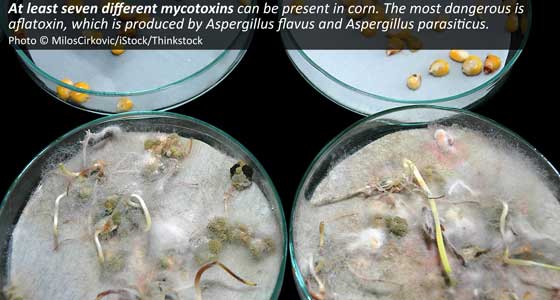Reducing the Risk of Mycotoxins
INSIDE ACADEMIA (Online Exclusive)

In developed countries, food safety policies tend to focus on foodborne pathogens of bacterial or viral origin and the [imagined] risk to humans caused by processed food or genetically engineered crops. However, another threat to food safety affects 25% of the world’s food crops, and food processing and genetic engineering may be effective ways to control it: mycotoxins. Felicia Wu, a professor in the department of food science and human nutrition at Michigan State University, describes the prevalence of mycotoxins, the public health risks they pose, and strategies to reduce their presence.
“Mycotoxins are toxins that are produced by fungi. The prefix ‘myco’ means fungal or related to fungi. Not all fungi produce toxins, and here we’re talking about microfungi, not macrofungi like mushrooms,” says Wu. Mushrooms and other macrofungi produce mushroom poisons. Molds produce mycotoxins as secondary metabolites, and scientists are not sure why, but they have theories. “We have good hypotheses as to why fungi produce these toxins. In some cases, for example, with the Fusarium fungi, if they produce the toxin, they are better able to colonize [a] crop,” Wu explains. In other cases, microfungi produce toxins in response to environmental stress. As the earth’s climate continues to change, mycotoxins may become more prevalent as microfungi that produce mycotoxins flourish during extreme weather events and in warmer temperatures. “Some people have hypothesized that it’s a way that [a] fungus has of dealing with reactive oxygen species that the plants put off when they sense they’ve been infected with the fungus. If you think about us becoming infected by a virus, bacterium, or fungus, our immune system tries to respond to it. And in turn, the virus or bacterium or fungus tries to stay alive on us, so they will react in a number of ways.” Thus, mycotoxins may be a means of protection from microorganisms, insects, plant defense mechanisms, humans, and animals. Consequently, mycotoxins are toxic to humans and other animals in low concentrations, causing severe illness and even death.
“Compared with a lot of the other toxins that are well known to humans, mycotoxins are fairly new. And we’re discovering new ones all the time. The question is how important are they to human health and how common are they in our food supply,” Wu says. Certain mycotoxins can have acute or chronic toxicity, resulting in birth defects, cancer, immunosuppression, kidney or liver failure, and so on. Of the more than 300 different mycotoxins that have been identified, only about five are responsible for the greatest agricultural, economical, and health impacts: zearalenone, trichothecenes, ochratoxin A, fumonisins, and aflatoxins.

Zearalenone is a mycotoxin that can result from a number of Fusarium molds growing in corn, wheat, barley, oats, and sorghum. It has been implicated as the cause of genital and reproductive problems in certain farm animals. Trichothecene mycotoxins are produced by multiple genera of microfungi that can occur in building substrates as well as foods. The most relevant agricultural trichothecene affecting humans is deoxynivalenol (also known as vomitoxin), which can be present in corn, barley, oats, rye, wheat, and other grains. Deoxynivalenol affects the immune system and the gastrointestinal system, causing diseases in humans and other animals. Fumonisins are a group of mycotoxins produced by certain Fusarium species; they occur most commonly in corn but can also contaminate wheat, sorghum, and other cereal crops. The most toxic of these is Fumonisin B1, which causes fatal diseases in horses, pigs, and rabbits and has been associated with esophageal cancer in humans. “Fumonisin was not discovered until 1988, and it was discovered in two different parts of the world: South Africa and the United States,” Wu says. “That was a drought year in the United States, [and] under drought conditions, the corn becomes very susceptible to infection by the fungus Fusarium verticillioides. … So there was a lot of fumonisin in corn in certain parts of the United States: Horses were dying of a brain disease called the staggers that was associated with fumonisin in corn. At the same time, in South Africa fumonisin was discovered in connection with beer that was being made from moldy corn.”
Ochratoxins are a group of mycotoxins produced by several species of Aspergillus fungi and one Penicillium species and can contaminate cereal grains, cocoa, coffee, figs, grapes, tree nuts, and many other commodities. Ochratoxin A is the most common and most toxic of the ochratoxins; it is a nephrotoxin in all animal species, hepatotoxic in many animals, and may be carcinogenic. “Mycotoxins such as fumonisins, deoxynivalenol (or vomitoxin), and ochratoxin A have been associated with human diseases. My colleagues around the world have done studies that associate fumonisin with esophageal cancer and neural tube defects in other animal species. Some work has been done relating deoxynivalenol or vomitoxin to growth impairment, particularly in other animal species, [and] ochratoxin A has been implicated in kidney diseases in a variety of animal species, but the human evidence is a lot less clear-cut.”
The most studied and most toxic of all mycotoxins is aflatoxin B1; it is one of four major aflatoxins (aflatoxins B1, B2, G1, and G2) that can be present in foods. The two main aflatoxin-producing molds, Aspergillus flavus and Aspergillus parasiticus, can grow on many foods but are predominantly seen on corn, peanuts, and tree nuts growing in tropical and subtropical geographic areas. “That unfortunately includes a large swath of Sub-Saharan Africa, East Asia, and South and Southeast Asia. And in the United States, aflatoxin is perennially a problem in the corn and peanuts that are grown in the southern states—roughly from Arizona all through Texas and all the way up to the Carolinas,” Wu says. Aflatoxins are not only an agricultural issue but also a major global public health issue. “Other health effects have been associated with other mycotoxins in crops, but the evidence is not as clear-cut as the case for aflatoxin,” Wu says. “Aflatoxin … causes the worst human health effects around the world. We have incontrovertible evidence that aflatoxin causes liver cancer.”
Consequently, the International Agency for Research on Cancer classifies all naturally occurring aflatoxins as Group 1 carcinogens. Aflatoxins can also compromise the immune system and cause liver failure and death in humans and other animals. “In 2004–2005 in Kenya, extremely high levels of aflatoxin in the corn led to more than 300 cases of acute aflatoxicosis and something like 125 reported deaths. There were probably even more than that,” Wu says. For these reasons, aflatoxins are considered especially dangerous even though they are not the most common mycotoxins in food. “Ochratoxin A is in many more food commodities and also drinks because it is produced by both warm-weather and cool-weather fungi,” Wu says, “but to our knowledge, it’s not nearly as harmful to human health as aflatoxin is.” In fact, aflatoxin B1 is one of the most potent carcinogens known to humankind. Wu and her colleagues used the population attributable risk method to determine the global burden of disease that can be attributed to mycotoxins. They determined that 21%–24% of global liver cancer cases are caused by aflatoxin B1. “That’s a pretty substantial amount. That gave us a value of up to 172,000 cases. … It is especially dangerous for individuals whose livers are already compromised because of chronic infection with hepatitis B or hepatitis C,” Wu adds.
In Sub-Saharan Africa, East Asia, and Southeast Asia, there is a high incidence of chronic hepatitis B infection and the climate is favorable for the growth of Aspergillus flavus and Aspergillus parasiticus. The combination of these factors renders the corn and peanuts grown in these regions at high risk for aflatoxin contamination. In contrast, a lot of corn is planted and grown in the United States, but incidence of aflatoxin contamination is rare. “We plant a lot of corn in Iowa, Illinois, and Indiana, but most of the time it’s cool enough that Aspergillus flavus is not a problem,” Wu explains. “It’s been said that we in the U.S. eat a lot of corn and a lot of corn products, but by and large, there’s not a lot of aflatoxin in our corn products—not only because a lot of our corn comes from the corn belt, where there isn’t much aflatoxin to begin with, but also because we process it so much.” Extrusion, a processing technique used to produce cold and hot cereals such as corn flakes and grits, exposes corn to high temperatures, high pressure, and sometimes glucose—all of which inactivate mycotoxins in grains. In addition, because damage from insects and extreme environmental conditions predisposes corn and other crops to contamination by toxigenic fungi, Wu asserts that transgenic crops such as Bt corn are an underutilized effective means of reducing levels of mycotoxins in food crops.
Other intervention strategies include encouraging populations in developing countries to diversify their diets and improve food storage methods. “There are some parts of the world where corn and/or peanuts are the main dietary staples. For example, in a particular area of Tanzania, 70% of the diet is corn,” Wu says, and corn is particularly susceptible to contamination by aflatoxins and fumonisins. Sorghum, rice, and millet have much lower incidence of mycotoxin contamination; their addition to the diets of Tanzanians and other populations would reduce chronic exposure to mycotoxins. In addition, leafy green vegetables and cruciferous vegetables (broccoli, brussels sprouts, cabbage, kale, and so on) contain nutrients that either directly reduce the amount of mycotoxins absorbed into the bloodstream or activate liver enzymes that aid in detoxification. In the case of aflatoxins, “You want to make sure that you’re storing your food in relatively dry conditions and relatively low temperatures to control the fungus,” Wu says. “Warm and wet conditions are the worst.” Stored food should be kept as cool and dry as possible. “And you also want to prevent pests from getting into [the] food and vectoring the fungus,” she adds.
Toni Tarver is senior writer/editor of Food Technology magazine ([email protected]).
